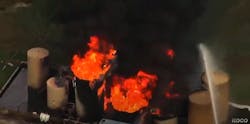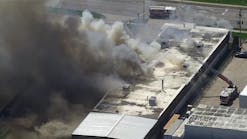Statistics show that over 60% of all confined space fatalities involve would-be rescuers. That includes, but is not limited to, emergency response personnel. Potential rescuers include fellow employees who succumb to a “knee-jerk” reaction to go into a confined space to help someone in trouble. It is important that responders, especially EMS personnel who may be called first to a person down, don’t react to a person in trouble in a confined space without taking the proper precautions for self-protection or they too may become victims.
The U.S. Occupational Safety & Health Administration (OSHA) defines a confines space as “a space that is large enough and so configured that an employee can bodily enter and perform assigned work; and has limited or restricted means for entry or exit (for example, tanks, vessels, silos, storage bins, hoppers, vaults, and pits are spaces that may have limited means of entry); and is not designed for continuous employee occupancy.” Confined spaces can be found in many locations in almost any community from shipyards to farms. In addition to industry, public utilities such as sewer and utility manholes are included.
Hidden Hazards
Confined spaces contain hidden hazards that can lead to deaths and injuries of workers and emergency responders within a very short time following entry if proper entry procedures are not followed. Two key factors often result in fatal injuries in confined spaces:
2. Inadequate or incorrect actions by emergency responders.
Response personnel are trained to respond quickly and take action when someone is trapped or injured. Since most of the dangers associated with confined spaces are not evident without monitoring instruments, personnel react to the circumstances and attempt to render aid without thinking of the consequences. A confined space response is like a combination technical rescue and hazardous materials incident: someone has entered a confined space and has been overcome by toxic fumes or a lack of oxygen.
Because openings are often small with unusual configurations of the space itself, specialized equipment and training are required to mount a successful technical rescue. Because the space may also contain a hazardous atmosphere as a result of some type of hazardous material being present or from a lack of oxygen to sustain life, special consideration for respiratory protection is required.
Factors in Fatalities
According to OSHA, 65% of all confined space fatalities occur because of hazardous atmospheres. OSHA defines a hazardous atmosphere as one that “may expose employees to the risk of death, incapacitation, impairment of ability to self-rescue (that is, escape unaided from a confined space), injury or acute illness” from one or more of the following causes:
- Flammable gas, vapor or mist in excess of 10% of its lower flammable (explosive) limit (LEL).
- Airborne combustible dust at a concentration that meets or exceeds its LFL. Note: This concentration may be approximated as a condition in which the dust obscures vision at a distance of five feet or less.
- Atmospheric oxygen concentration below 19.5% percent or above 23.5%.
- Atmospheric concentration of any substance for which a dose or a permissible exposure limit is published in Subpart G, Occupational Health and Environmental Control, or in Subpart Z, Toxic and Hazardous Substances, and which could result in employee exposure in excess of its dose or permissible exposure limit. Note: An atmospheric concentration of any substance that is not capable of causing death, incapacitation, impairment of ability to self-rescue, injury or acute illness due to its health effects is not covered by this provision.
- Any other atmospheric condition that is immediately dangerous to life or health. Note: Immediately dangerous to life and health (IDLH) means any condition that poses an immediate or delayed threat to life or that would cause irreversible adverse health effects or that would interfere with an individual’s ability to escape unaided from a permit space.
Some materials — hydrogen fluoride gas and cadmium vapor, for example—may produce immediate transient effects that, even if severe, may pass without medical attention, but are followed by sudden, possibly fatal collapse 12 to 72 hours after exposure. The victim “feels normal” from recovery from transient effects until collapse. Such materials in hazardous quantities are considered to be “immediately” dangerous to life or health.
Monitoring Required
OSHA regulations require that any confined space entry, including emergency response, be preceded by testing of the internal atmosphere with a calibrated direct-reading instrument for oxygen content, for flammable gases and vapors, and for potential toxic air contaminants, in that order. Monitoring should be continuous while anyone is in the confined space. Investigations conducted by the National Institutes for Occupational Safety and Health (NIOSH) indicate that workers usually do not recognize that they are working in a confined space and that they may encounter unforeseen hazards. Testing and evaluation of the atmosphere are typically not initiated prior to entry and monitoring is not performed during the confined space work procedures, which results in the need for rescue.
Oxygen content of a confined space includes both oxygen-deficient and oxygen-enriched atmospheres. Oxygen deficiency results from chemical or biological reactions that displace or consume available oxygen within a confined space. Biological action can cause oxygen depletion in excavations and manholes located near garbage dumps, landfills or swampy areas. Chemical reactions that occur slowly as in the rusting of metals on the surface of tanks, vats and ship holds can deplete oxygen in a confined space.
Consumption of oxygen can also occur during welding, cutting or brazing operations. As a result of displacement of the oxygen in a confined space, asphyxiation can occur to anyone entering the space without self-contained breathing apparatus (SCBA). This is also known as “simple asphyxiation.”
Ambient air usually has an oxygen content of around 21%. Once the oxygen level drops below 17%, the initial signs of hypoxia start to occur as breathing becomes faster and heartbeat increases. Hypoxia occurs when the depletion of oxygen reaches the cellular level and causes damage. At oxygen concentrations of 14% to 15%, breathing is increased further, rapid heartbeat, lack of muscular coordination, fatigue and irregular respiration occurs. When the oxygen level reaches 6% to 10%, nausea, vomiting, inability to perform and unconsciousness occur. When levels fall below 6%, rapid unconsciousness occurs followed by death within minutes.
Displacement of oxygen may occur from a chemical with additional hazards beyond asphyxiation, including toxicity and flammability. These additional hazards can further complicate the entry of employees or rescue personnel. Oxygen-enriched atmospheres can also be dangerous because they can increase the risk of combustion. Levels greater than 25% are considered oxygen-enriched atmospheres. The bottom line is that before anyone enters a confined space, the space must be monitored to determine whether there is enough oxygen to work safely.
Response personnel should wear SCBA whenever they enter a confined space to perform a rescue or an investigation. Attempting to enter a confined space with the idea that you will hold your breath to make a rescue or that you will don your SCBA once you enter the space can be a fatal mistake and should never be attempted. In most cases, entry into confined spaces occurs through a small or restricted opening that requires additional effort to accomplish.
Once in the space, mobility is often reduced by impediments such as piping or baffles. These actions will take time and reduce your ability to hold your breath, even though you think you can based on past efforts to hold your breath for a time under less physical or stressful circumstances. If the size of the opening to the confined space does not allow entry with the SCBA tank on your back, then don the mask and start air flow outside the space, have the tank passed to you when you enter, then place it on your back once inside, if possible. If available, hose-supplied SCBA are easier to use in a confined space and increase the amount of air available.
Response Dangers
Here is an outline of conditions encountered in confined spaces:
Oxygen (O). Oxygen is a diatomic element (exists naturally as O2) that is an odorless, tasteless and colorless gas making up 21.5% of the air we breathe. It is not flammable or toxic, but does support combustion. Oxygen can be liquefied, becoming a slightly bluish liquid with a boiling point of –183 degrees Celsius. It has a vapor density (gas) of 1.429 and it may explode (liquid) on contact with heat or oxidizable materials. Therapeutic overdoses can cause convulsions.
Flammable atmospheres in confined spaces usually result from methane, also known as natural gas, hydrogen sulfide and carbon monoxide. Other flammable vapors can also be present as a result of spills or leaks from other locations. Most gases and vapors are heavier than air and may enter confined spaces underground when released.
Even if flammable vapors are present, there must be a proper mixture of flammable vapor and oxygen in the presence of an ignition source for ignition to occur. This mixture of oxygen and flammable vapor is known as the flammable range. Flammable range is measured on a scale from 0% to 100%. On this scale, each flammable vapor has a range in which there is a proper mixture of oxygen and vapor for combustion to occur.
Flammable ranges are composed of a lower explosive limit (LEL) and an upper explosive limit (UEL). Monitoring instruments are available that measure for a percentage of the LEL. When 10% of the LEL is reached, response personnel should not enter the confined space until fresh air is pumped in. The danger of introducing fresh air into a confined space where a flammable vapor is present is that you may well bring the mixture into its flammable range, if it was not already. Therefore, after the induction of air and during entry, the space must be continually monitored to detect changes in the atmosphere that may present a danger to personnel.
Methane (CH4). Methane is a colorless, odorless and tasteless gas that is lighter than air, with a vapor density of 0.554. It is an asphyxiant gas that is flammable with a flash point of –306 degrees Fahrenheit and an autoignition temperature of 1,000F. Its flammable range is 5-15% in air.
Gasoline fumes. Gasoline is a mixture of liquid hydrocarbons. Different manufacturers produce different formulations affecting physical characteristics. As a liquid, gasoline is very flammable and volatile (readily forms vapor at ambient temperatures) with vapors that are heavier than air and can enter below ground and other confined spaces. The boiling and flash points are well below zero.
Propane (C3H8). Propane is a colorless liquefied gas that is highly flammable, a potential asphyxiant, and heavier than air so it can pool in below ground confined spaces. It has a boiling point of –42.5C and a flash point of –150F. The ignition temperature for propane is 874F. Propane has a flammable range of 2.4% to 9.5% in air.
Toxic vapors in a confined space can also be dangerous to workers and rescuers. Examples of toxic gases that have caused deaths in workers in confined spaces are carbon monoxide, hydrogen cyanide, and hydrogen sulfide (all also flammable), chlorine and ammonia. Ammonia is particularly dangerous in confined spaces because it is fairly easy to be found within its flammable range in confined areas, so in addition to toxicity, you need to worry about flammability.
Vapors can accumulate in confined spaces naturally (residue) or from chemical or biological process, other leaks and spills, through the use of other chemicals to clean or process tanks, and from welding or other hot work operations within a tank or space. Some gases such as hydrogen sulfide are extremely toxic and can cause paralysis of the olfactory system (loss of sense of smell), loss of reasoning, respiratory failure, unconsciousness and death. When the sense of smell is lost the person in the space thinks the hazardous material is gone when in fact it is not, they just can’t smell it any longer. Here are some examples:
Carbon monoxide (CO). Carbon monoxide is a colorless, odorless gas that is slightly lighter than air at 0.96716 (air equals 1.0). It is highly toxic by inhalation, highly flammable and has a wide flammable range of 12 to 75% in air. Carbon monoxide is a chemical asphyxiant that displaces oxygen in the blood. It has an affinity for blood over 200 times that of oxygen.
Hydrogen sulfide H2S). Hydrogen sulfide is a colorless gas with an offensive odor sometimes likened to rotten eggs. It is highly toxic, with an IDLH of 1,200 ppm, flammable, and heavier than air. It has a wide flammable range of 4.3% to 46% in air. It should be noted that gases and vapors with wide flammable ranges are likely to burn inside containers and confined spaces, unlike those with narrow ranges, like gasoline, that would be too rich to burn in a container or confined space.
Hydrogen cyanide (HCN). Hydrogen cyanide, also known as hydrocyanic acid, is a gas that has a faint odor of bitter almonds and a vapor density of 0.938, which makes it lighter than air. It is toxic by inhalation with an IDLH of 50 ppm, and flammable, with a wide flammable range of 6% to 41%. Its flash point is zero degrees Fahrenheit and the autoignition temperature is 1,000F.
Anhydrous ammonia (NH3). Anhydrous ammonia is a colorless gas with a sharp, intensely irritating odor. It is corrosive, toxic and flammable under certain conditions. The IDLH is 300 ppm and it is toxic by inhalation. Ammonia also seeks water in moist parts of the body and can cause chemical burns when it combines with water on the skin. Ammonia has a flammable range of 16% to 25% in air and an autoignition temperature of 1,204F. It is a serious fire hazard inside of buildings and confined spaces.
Chlorine (Cl2). Chlorine is an elemental gas that is toxic and an oxidizer. When in contact with organic materials, it can react explosively. It is toxic by inhalation with an IDLH of 10 ppm. Chlorine is heavier than air.
Added Hazards
Hazardous materials other than those usually expected to be found in confined spaces can be spilled during incidents and find their way into confined spaces, especially those in which vapors are heavier than air. Response personnel must be aware of this potential and plan tactics accordingly. Dust can also be a hazard in a confined space that can result in dust explosions, respiratory difficulty, injury and death.
Confined space entry may produce exposure to elevated or reduced temperature conditions resulting in an increase or decrease in body temperature, both to victims and rescuers. Hazmat personnel experience some of the same exposures to heat and cold stress during entry into incident scenes in chemical protective clothing. Rescue personnel should be prepared to deal with heat stress types of injury in addition to any other potential dangers in confined spaces.
The National Fire Protection Association (NFPA) has established training competency levels for emergency personnel responding to emergencies in confined spaces in NFPA 1670 Operations and Training for Technical Rescue Incidents. NFPA has established three levels of operational capabilities for personnel responding to confined space emergencies: awareness, operations and technician.
Awareness level. Awareness personnel do not make entries into confined spaces; they are primarily attendant or support personnel. They must be able to recognize confined space emergencies, make proper notifications, initiate contact with victims if possible, implement emergency response system for confined space emergencies, and implement site control and scene management.
Operations and technician are the levels of training that allow entry into a confined space.
Operations level. Operations personnel are involved in protecting personnel, size-up, identification of the duties of the rescue entrants and backup, monitoring procedures and entry-type rescue procedures and others.
Technician level. Technicians are involved in medical monitoring of rescue team members, planning response for entry-type rescues in hazardous environments and implementation of the planned response and others.
OSHA believes that education on confined spaces and training on proper entry techniques could lead to prevention of 85% of the deaths and injuries resulting from confined space entry operations. This would likely result in the reduction of deaths and injuries among emergency response personnel as well. All emergency response personnel who may respond to a confined space rescue incident should be trained to a minimum of the awareness level for such response, including fire, police, hazmat and EMS.
Conclusion
Entry into a confined space requires respiratory protection, protective clothing, a harness, life lines and a standby person. If there are no personnel who are trained beyond awareness at the local level, then you should know where such trained personnel are located and the notification procedures and lead time required to get them to your scene.
Confined space awareness training does not require an additional training class; it can be made a part of basic hazardous materials awareness, which is required by OSHA and the U.S. Environmental Protection Agency (EPA) for all emergency response personnel. Many state training organizations have confined space rescue classes available for personnel who may need to make entry into such spaces.
Robert Burke, a Firehouse® contributing editor, is the fire marshal for the University of Maryland. He is a Certified Fire Protection Specialist (CFSP), Fire Inspector II, Fire Inspector III, Fire Investigator and Hazardous Materials Specialist, and has served on state and county hazardous materials response teams. Burke is a veteran of 24 years in fire and emergency services, with experience in career and volunteer departments. He has attained the rank of lieutenant, assistant chief and deputy state fire marshal. Burke is an adjunct instructor at the National Fire Academy and the Community College of Baltimore, Catonsville Campus, and the author of the textbooks Hazardous Materials Chemistry for Emergency Responders and Counter Terrorism for Emergency Responders. He can be reached in the Internet at [email protected].





